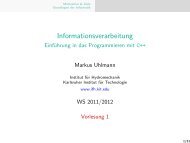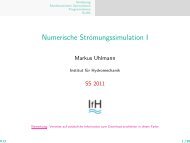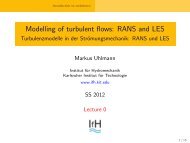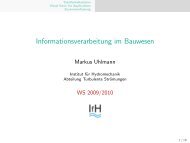Etude de mod`eles de fermeture au second ordre et contribution `a ...
Etude de mod`eles de fermeture au second ordre et contribution `a ...
Etude de mod`eles de fermeture au second ordre et contribution `a ...
Create successful ePaper yourself
Turn your PDF publications into a flip-book with our unique Google optimized e-Paper software.
vi TABLE DES MATI ÈRES<br />
2.3 Traitement <strong>de</strong>s termes visqueux . . . . . . . . . . . . . . . . . . . . . . . . . . . . . 59<br />
2.3.1 Le vecteur <strong>de</strong>s flux . . . . . . . . . . . . . . . . . . . . . . . . . . . . . . . . 60<br />
2.3.2 Les termes sources . . . . . . . . . . . . . . . . . . . . . . . . . . . . . . . . 60<br />
2.4 Une métho<strong>de</strong> <strong>de</strong> résolution implicite . . . . . . . . . . . . . . . . . . . . . . . . . . 61<br />
2.4.1 Construction du résidu implicite linéarisé . . . . . . . . . . . . . . . . . . . 61<br />
2.4.2 Prépondérance <strong>de</strong>s flux convectifs . . . . . . . . . . . . . . . . . . . . . . . . 62<br />
2.4.3 Précision spatiale . . . . . . . . . . . . . . . . . . . . . . . . . . . . . . . . . 63<br />
2.4.4 Couplage entre les équations . . . . . . . . . . . . . . . . . . . . . . . . . . 63<br />
2.4.5 Résolution itérative du système linéaire . . . . . . . . . . . . . . . . . . . . 65<br />
2.4.6 Quelques remarques sur la convergence <strong>de</strong> la métho<strong>de</strong> implicite . . . . . . . 65<br />
2.5 Traitement <strong>de</strong>s conditions <strong>au</strong>x limites . . . . . . . . . . . . . . . . . . . . . . . . . 66<br />
2.5.1 La formulation du bilan à la frontière . . . . . . . . . . . . . . . . . . . . . 67<br />
2.5.2 Les frontières libres . . . . . . . . . . . . . . . . . . . . . . . . . . . . . . . . 68<br />
2.5.3 Le traitement <strong>de</strong>s parois soli<strong>de</strong>s . . . . . . . . . . . . . . . . . . . . . . . . . 69<br />
2.5.4 Une condition <strong>de</strong> périodicité . . . . . . . . . . . . . . . . . . . . . . . . . . . 73<br />
3 <strong>Etu<strong>de</strong></strong> <strong>de</strong>s écoulements turbulents homogènes 74<br />
3.1 La motivation pour l’étu<strong>de</strong> <strong>de</strong>s écoulements homogènes . . . . . . . . . . . . . . . . 74<br />
3.2 Ecoulement homogène cisaillé d’un flui<strong>de</strong> incompressible . . . . . . . . . . . . . . . 75<br />
3.2.1 Caractéristiques <strong>de</strong> l’écoulement . . . . . . . . . . . . . . . . . . . . . . . . 75<br />
3.2.2 Comportement <strong>de</strong>s modèles du <strong>second</strong> <strong>ordre</strong> . . . . . . . . . . . . . . . . . . 77<br />
3.3 L’écoulement homogène cisaillé d’un flui<strong>de</strong> compressible . . . . . . . . . . . . . . . 79<br />
3.3.1 Tendances observées dans les simulations directes . . . . . . . . . . . . . . . 80<br />
3.3.2 Prédictions avec la <strong>ferm<strong>et</strong>ure</strong> du <strong>second</strong> <strong>ordre</strong> . . . . . . . . . . . . . . . . . 86<br />
3.4 Conclusion . . . . . . . . . . . . . . . . . . . . . . . . . . . . . . . . . . . . . . . . 89<br />
4 <strong>Etu<strong>de</strong></strong> <strong>de</strong>s écoulements inhomogènes, libres 91<br />
4.1 Introduction . . . . . . . . . . . . . . . . . . . . . . . . . . . . . . . . . . . . . . . . 91<br />
4.2 La couche <strong>de</strong> mélange en régime incompressible . . . . . . . . . . . . . . . . . . . . 91<br />
4.2.1 Présentation du cas test . . . . . . . . . . . . . . . . . . . . . . . . . . . . . 92<br />
4.2.2 Résultats <strong>de</strong>s calculs . . . . . . . . . . . . . . . . . . . . . . . . . . . . . . . 93<br />
4.2.3 Conclusion . . . . . . . . . . . . . . . . . . . . . . . . . . . . . . . . . . . . 95<br />
4.3 La couche <strong>de</strong> mélange en régime compressible . . . . . . . . . . . . . . . . . . . . . 96<br />
4.3.1 Influence <strong>de</strong> la compressibilité sur le développement <strong>de</strong> l’écoulement . . . . 96<br />
4.3.2 Les approches pour expliquer la stabilisation <strong>de</strong> la couche <strong>de</strong> mélange . . . 99<br />
4.3.3 L’analogie entre le cisaillement homogène <strong>et</strong> la couche <strong>de</strong> mélange . . . . . 100<br />
4.3.4 Les étu<strong>de</strong>s numériques précé<strong>de</strong>ntes . . . . . . . . . . . . . . . . . . . . . . . 101<br />
4.3.5 Les calculs effectués avec nos <strong>ferm<strong>et</strong>ure</strong>s du <strong>second</strong> <strong>ordre</strong> . . . . . . . . . . 102<br />
4.3.6 Conclusion . . . . . . . . . . . . . . . . . . . . . . . . . . . . . . . . . . . . 106<br />
5 Ecoulements compressibles <strong>et</strong> parois 108






